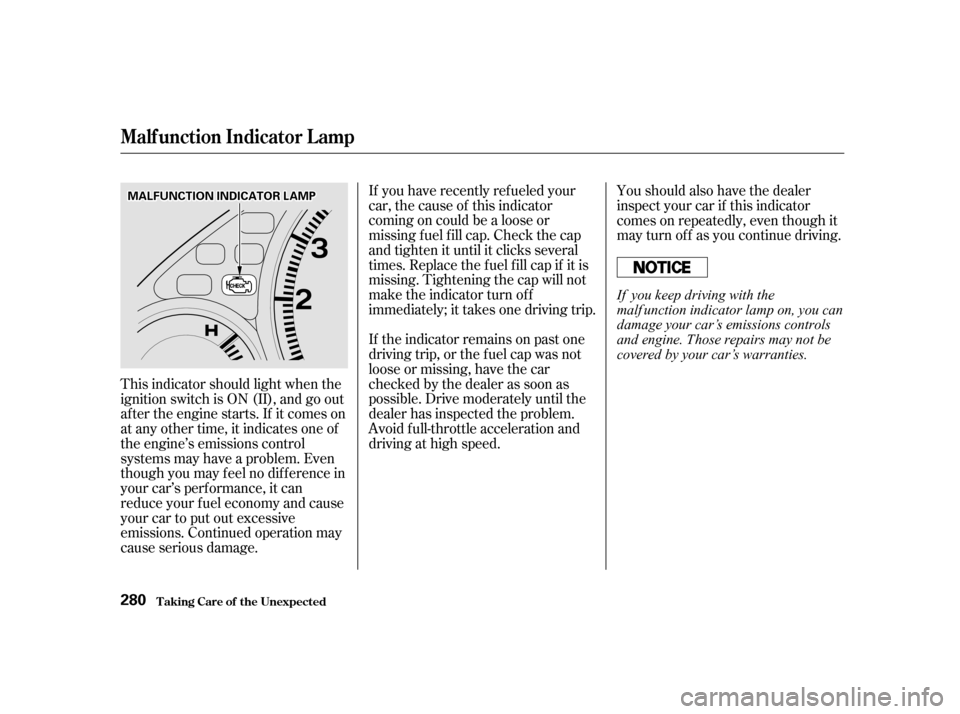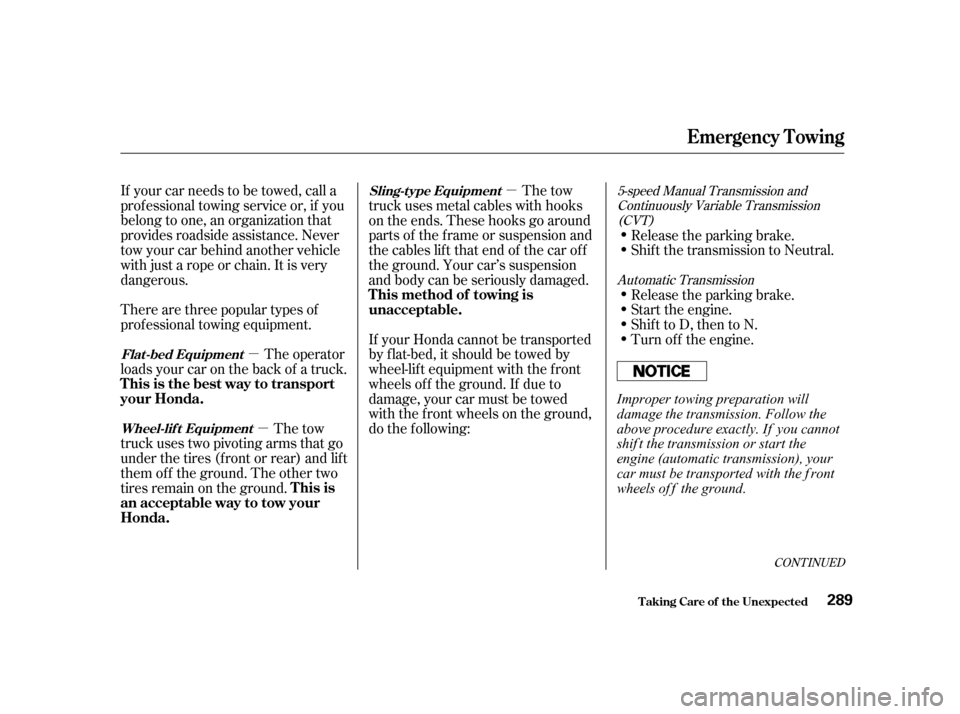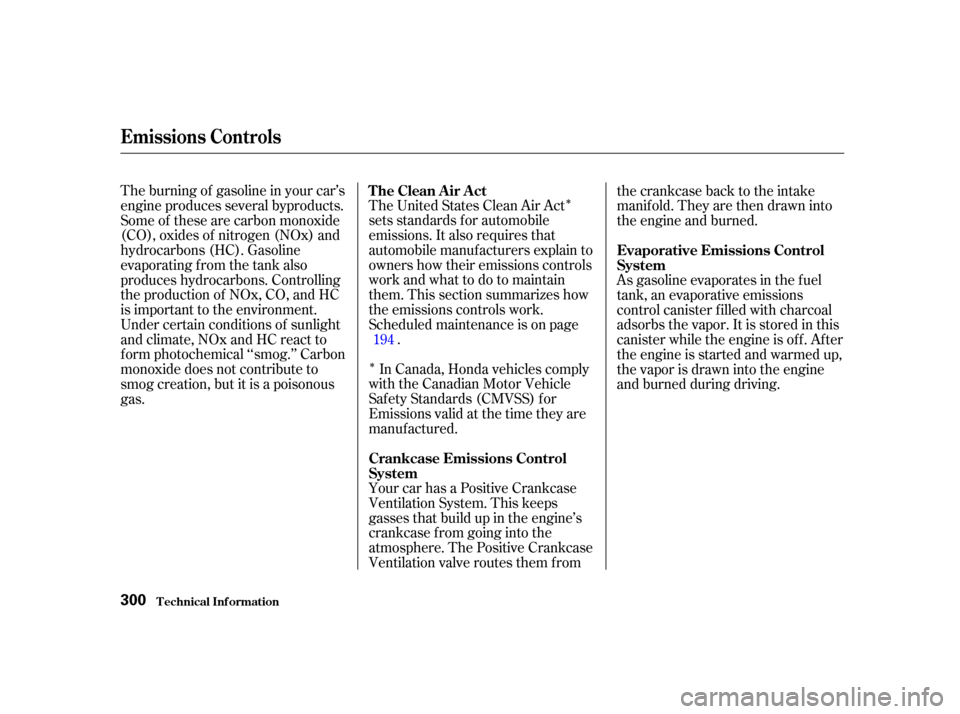Page 283 of 325

If you have recently ref ueled your
car, the cause of this indicator
coming on could be a loose or
missing f uel f ill cap. Check the cap
and tighten it until it clicks several
times. Replace the fuel fill cap if it is
missing. Tightening the cap will not
make the indicator turn of f
immediately; it takes one driving trip.
If the indicator remains on past one
driving trip, or the f uel cap was not
loose or missing, have the car
checked by the dealer as soon as
possible. Drive moderately until the
dealer has inspected the problem.
Avoid full-throttle acceleration and
driving at high speed.Youshouldalsohavethedealer
inspect your car if this indicator
comes on repeatedly, even though it
may turn of f as you continue driving.
This indicator should light when the
ignition switch is ON (II), and go out
af ter the engine starts. If it comes on
at any other time, it indicates one of
the engine’s emissions control
systems may have a problem. Even
though you may f eel no dif f erence in
your car’s perf ormance, it can
reduce your f uel economy and cause
your car to put out excessive
emissions. Continued operation may
cause serious damage.
Malf unction Indicator L amp
T aking Care of t he Unexpect ed280
M M A
AL
LFFUUN NCCTTI
IOON N I
INND DI
ICCA A T
TO
OR R L
LAA M
M P
P
If you keep driving with the
malf unction indicator lamp on, you can
damage your car’s emissions controls
and engine. Those repairs may not be
covered by your car’s warranties.
Page 284 of 325
Your car has certain ‘‘readiness
codes’’ that are part of the on-board
diagnostics f or the emissions
systems. In some states, part of the
emissions testing is to make sure
these codes are set. If they are not
set, the test cannot be completed.
If your car’s battery has been
disconnected or gone dead, these
codes are erased. It takes several
days of driving under various
conditions to set the codes again.If possible, do not take your car f or a
state emissions test until the
readiness codes are set. To check if
they are set, turn the ignition ON (II),
but do not start the engine. The
Malf unction Indicator Lamp will
come on f or 20 seconds. If it then
goes of f , the readiness codes are set.
If it blinks 5 times, the readiness
codes are not set. See State
Emissions Testing on page .
301
Readiness Codes
Malf unction Indicator L amp
T aking Care of t he Unexpect ed281
Page 287 of 325
All the electrical circuits in your car
have fuses to protect them from a
short circuit or overload. These
f uses are located in two f use boxes.The interior f use box is underneath
the steering column. To open it, turn
the knobs as shown.
The under-hood f use box is located
in the engine compartment on the
passenger’s side. To open it, push
thetabsasshown.
Fuses
T aking Care of t he Unexpect ed284
T T
A
A B
B
U
UN
NDDE
ER
R- -H
H O
OO ODD I
INNT TE
ER
RI IOOR R
Page 292 of 325

�µ
�µ �µ
The tow
truck uses two pivoting arms that go
under the tires (f ront or rear) and lif t
them of f the ground. The other two
tires remain on the ground. If your car needs to be towed, call a
prof essional towing service or, if you
belong to one, an organization that
provides roadside assistance. Never
tow your car behind another vehicle
with just a rope or chain. It is very
dangerous.
There are three popular types of
prof essional towing equipment.
The operator
loads your car on the back of a truck. The tow
truck uses metal cables with hooks
on the ends. These hooks go around
parts of the f rame or suspension and
the cables lif t that end of the car of f
the ground. Your car’s suspension
and body can be seriously damaged.
If your Honda cannot be transported
by f lat-bed, it should be towed by
wheel-lif t equipment with the f ront
wheels of f the ground. If due to
damage, your car must be towed
with the f ront wheels on the ground,
do the f ollowing: Release the parking brake.
Start the engine.
ShifttoD,thentoN.
Turn of f the engine. Release the parking brake.
Shif t the transmission to Neutral.
Automatic Transmission
5-speed Manual Transmission and
Continuously Variable Transmission(CVT)
CONT INUED
Wheel-lif t Equipment
Flat -bed Equipment Sling-t ype Equipment
T his is
an acceptable way to tow your
Honda. This is the best way to transport
your Honda. T his method of towing is
unacceptable.
Emergency T owing
T aking Care of t he Unexpect ed289
Improper towing preparation will
damage the transmission. Follow the
above procedure exactly. If you cannot
shif t the transmission or start the
engine (automatic transmission), your
car must be transported with the f ront
wheels of f the ground.
Page 295 of 325
Your car has several identif ying
numbers located in various places.
The Vehicle Identif ication Number
(VIN) is the 17-digit number your
Honda dealer uses to register your
car f or warranty purposes. It is also
necessary f or licensing and insuring
your car. The easiest place to find
the VIN is on a plate fastened to the
top of the dashboard. You can see it
by looking through the windshield
on the driver’s side. It is also on the
Certification label attached to the
driver’s doorjamb, and is stamped on
the engine compartment bulkhead.
The VIN is also provided in bar code
on the Certification label.
Identif ication Numbers
T echnical Inf ormation292
V VE
EH
H I
ICCL LEE I
IDD E
EN
NT TI
IFFI ICCA A T
TI
IOON N N
NUUMM B
BEER
R
C
CE ER
RT TI
IFFI ICCA A T
TI
IOON N L
LAA B
BEEL
L
Page 296 of 325
The Engine Number is stamped into
the engine block.
The Transmission Number is on a
label on top of the transmission.
Identif ication Numbers
T echnical Inf ormation293
E EN
NG GIINNE E N
NUUMM B
BEER
R
M
M
A
AN
NU UAAL
L T
TR
RA A N
NS SMM I
ISSS SIIOON N
N
NU UMM B
BEER
R A
A
U
UT TO
OM M A
AT
TI
ICC T
TR
RA A N
NS SMM I
ISSS SIIOON N N
NUUMM B
BEER
R
Page 297 of 325

�Î�Î�Î
�Î �Î
�Î
�Î
�Î
�Î
�Î
�Î
�Î
�Î
�Î
�Î
�Î
�Î
�Î
�Î
Specif ications
T echnical Inf ormation294
Dimensions
Weights
Engine Capacities
174.7 in (4,438 mm)
66.7 in (1,695 mm)
55.1 in (1,399 mm)
103.1 in (2,620 mm)
57.9 in (1,470 mm)
57.9 in (1,470 mm)
2.95 x 3.72 in (75.0 x 94.4 mm) 13.2 US gal (50
, 11.0 Imp gal)
101.7 cu-in (1,668 cm
)
9.5
9.9
Length
Width
Height
Wheelbase
Track
Gross vehicle weight rating See the certification label attached
to the driver’s doorjamb.
Type
BorexStroke
Displacement
Compression ratio
Spark plugs Water cooled 4-stroke
SOHC , SOHC VTEC
4-cylinder gasoline engine
See spark plug maintenance
section page 225 .
Excluding the oil remaining in the engine. Including the coolant in the reserve tank and that remaining in the
engine.
Reserve tank capacity: 0.108 US gal (0.41
, 0.090 Imp gal)
4.8 US qt (4.5
, 4.0 Imp qt)
2.6 US qt (2.5, 2.2 Imp qt)
6.0 US qt (5.7, 5.0 Imp qt)
6.3 US qt (6.0, 5.3 Imp qt)
3.3 US qt (3.1, 2.7 Imp qt)
2.9 US qt (2.7, 2.4 Imp qt)
1.7 US qt (1.6, 1.4 Imp qt)
1.6 US qt (1.5, 1.3 Imp qt)
4.4 US qt (4.2, 3.7 Imp qt)
3.5 US qt (3.3, 2.9 Imp qt)
3.2 US qt (3.0, 2.6 Imp qt)
3.7 US qt (3.5, 3.1 Imp qt)
3.4 US qt (3.2, 2.8 Imp qt)
Fuel tank
Engine
coolant
Engine oil
Automatic
transmission
fluid 1.03 US gal (3.9
, 0.86 Imp gal)
1.00 US gal (3.8, 0.84 Imp gal)
1.00 US gal (3.8, 0.84 Imp gal)
1.32 US gal (5.0
, 1.10 Imp gal)
1.29 US gal (4.9, 1.08 Imp gal)
1.29 US gal (4.9, 1.08 Imp gal)
Front
Rear Approx.
1:
2: U.S.: DX, LX
Canada: DX, LX
U.S.: HX, EX
Canada: Si
5:
1:
2:
3:
4:
HX
DX, LX
EX, HX Change
Manual
Automatic
CVT
Total Manual
Automatic
CVT
Change
Without filter
Total
Change
Total
Change
Total
U.S. Cars
Canada Cars
12
1
2 1
2
3
4
3
4
5
5
Manual trans-
mission fluidIncluding filter
Windshield
washer reservoir
Page 303 of 325

�Î�ÎIn Canada, Honda vehicles comply
with the Canadian Motor Vehicle
Saf ety Standards (CMVSS) f or
Emissions valid at the time they are
manuf actured. The United States Clean Air Act
sets standards f or automobile
emissions. It also requires that
automobile manufacturers explain to
owners how their emissions controls
workandwhattodotomaintain
them. This section summarizes how
the emissions controls work.
Scheduled maintenance is on page .
The burning of gasoline in your car’s
engine produces several byproducts.
Some of these are carbon monoxide
(CO), oxides of nitrogen (NOx) and
hydrocarbons (HC). Gasoline
evaporating from the tank also
produces hydrocarbons. Controlling
the production of NOx, CO, and HC
is important to the environment.
Under certain conditions of sunlight
and climate, NOx and HC react to
f orm photochemical ‘‘smog.’’ Carbon
monoxide does not contribute to
smog creation, but it is a poisonous
gas.
Your car has a Positive Crankcase
Ventilation System. This keeps
gasses that build up in the engine’s
crankcase from going into the
atmosphere. The Positive Crankcase
Ventilation valve routes them fromthe crankcase back to the intake
manif old. They are then drawn into
the engine and burned.
As gasoline evaporates in the f uel
tank, an evaporative emissions
control canister f illed with charcoal
adsorbs the vapor. It is stored in this
canister while the engine is of f . Af ter
the engine is started and warmed up,
the vapor is drawn into the engine
and burned during driving.
194
The Clean Air Act
Crankcase Emissions Control
System Evaporative Emissions Control
System
Emissions Cont rols
T echnical Inf ormation300